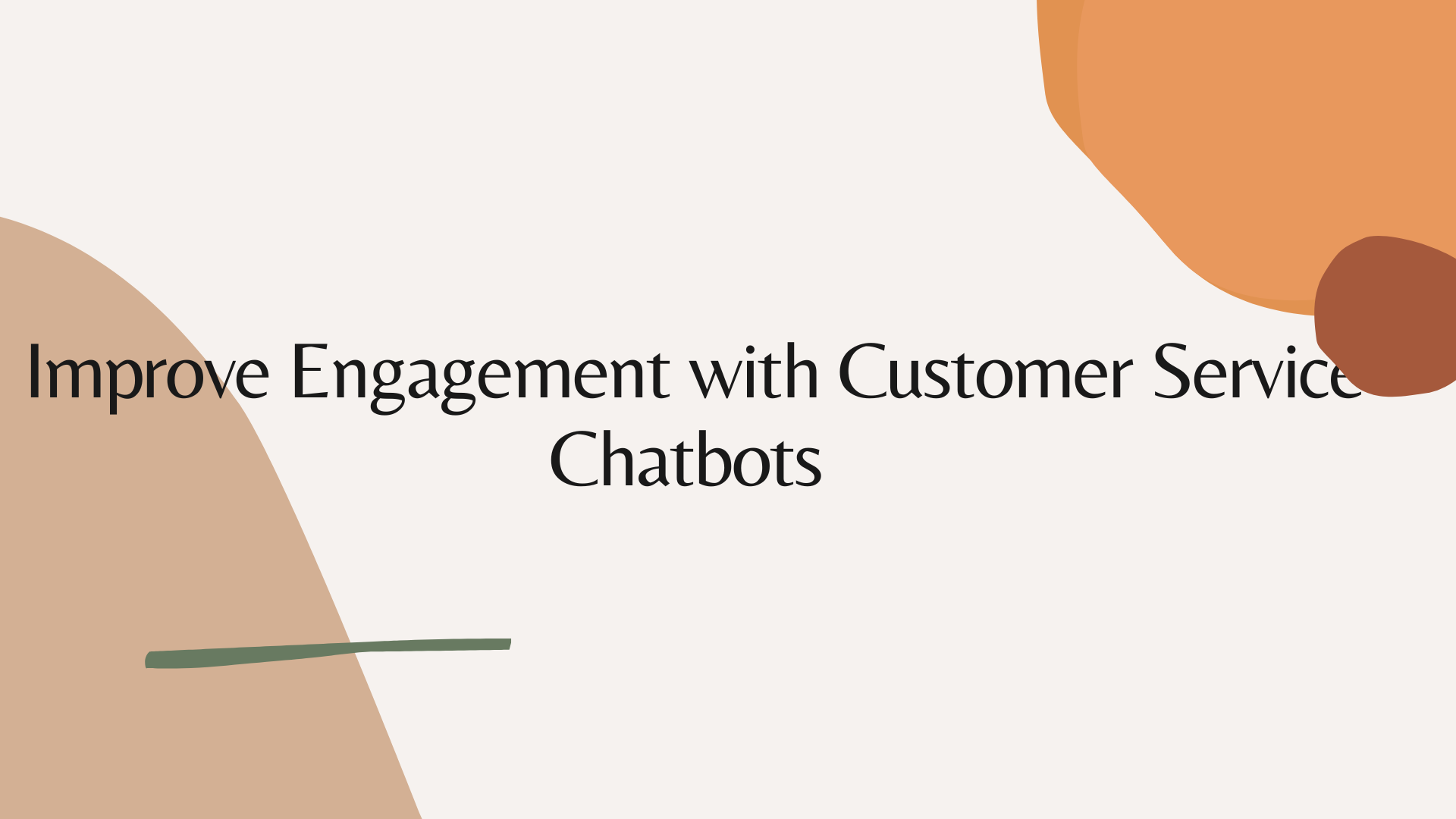Discover how customer service chatbots can boost engagement, streamline interactions, and create personalized experiences for your customers. Learn practical strategies to implement chatbots effectively and enhance customer satisfaction while reducing support costs.
In today’s fast-paced digital landscape, businesses are constantly seeking innovative ways to enhance customer engagement and streamline support processes. Enter customer service chatbots, the AI-powered virtual assistants that have revolutionized the way companies interact with their customers. In this comprehensive guide, we’ll explore the immense potential of chatbots to improve engagement, foster meaningful interactions, and ultimately elevate your customer service to new heights.
1. The Power of Customer Service Chatbots
Customer service chatbots are intelligent tools designed to interact with users in a conversational manner. They can handle various customer queries, provide real-time assistance, and offer personalized solutions, all while maintaining a human-like conversational flow. By integrating chatbots into your customer support strategy, you can provide round-the-clock service, increase response times, and scale your support efforts efficiently.
2. Streamlining Customer Interactions
One of the key benefits of customer service chatbots is their ability to streamline interactions. Instead of customers having to navigate through complex IVR systems or waiting for human agents, chatbots offer quick and relevant responses. With natural language processing (NLP) capabilities, chatbots can understand user intent, leading to more accurate and context-aware replies.
3. Personalized Customer Experiences
Personalization is a vital aspect of modern customer service, and chatbots excel in this area. By leveraging customer data and past interactions, chatbots can tailor responses to each user, making customers feel valued and understood. Personalized experiences not only improve engagement but also contribute to higher customer satisfaction and loyalty.
4. Proactive Customer Support
Customer service chatbots can be proactive in engaging with customers. They can reach out to users with helpful tips, product recommendations, or updates, offering valuable assistance even before customers initiate the conversation. Proactive customer support creates a positive impression, enhances brand loyalty, and boosts engagement.
5. Cost-Effective Customer Support
Implementing chatbots in your customer service strategy can lead to significant cost savings. Chatbots can handle a large number of queries simultaneously, reducing the workload on human agents and enabling your support team to focus on more complex tasks. This cost-effectiveness allows businesses to allocate resources more efficiently and invest in other critical areas.
6. Building Customer Trust
While some customers may initially be skeptical about interacting with chatbots, providing seamless and accurate assistance will build trust over time. As customers realize the value and convenience of chatbot interactions, they’ll be more willing to engage and rely on the chatbot for their support needs.
7. Implementing Customer Service Chatbots Effectively
To implement customer service chatbots effectively, consider the following strategies:
Clear Objectives:
Define the goals and objectives you want to achieve with your chatbot. Whether it’s handling FAQs, processing orders, or resolving specific issues, clarity is crucial for successful implementation.
Choosing the Right Platform:
Select a chatbot development platform that aligns with your business needs and technical expertise. Popular options include Dialogflow, ManyChat, and Chatfuel.
Natural Language Processing (NLP):
Implement NLP to enhance the chatbot’s understanding of user queries and improve the quality of responses
Seamless Integration:
Integrate your chatbot with your website, social media channels, and messaging apps to ensure a seamless user experience across platforms.
Testing and Iteration:
Thoroughly test your chatbot before deployment to identify and address any issues. Continuously iterate and update the chatbot based on user feedback and data analysis.
8. Balancing Automation and Human Touch
While chatbots bring numerous benefits, it’s essential to strike a balance between automation and the human touch. Some customer queries may require the empathy and problem-solving skills of human agents. Develop a protocol for transferring complex issues to human support agents, ensuring customers feel valued and heard.
Recommended reading: Avoid These 10 Costly Chatbot Mistakes That Drive Away Customers
Frequently Asked Questions
1. How do chatbots increase customer engagement?
Chatbots increase customer engagement through several key mechanisms:
Instant Response:
Chatbots offer real-time responses, eliminating wait times and keeping customers engaged without delays.
Personalization:
By leveraging customer data and past interactions, chatbots provide personalized recommendations and solutions, creating a more tailored and engaging experience.
Proactive Interaction:
Some chatbots can initiate conversations with users, offering assistance or relevant information, which encourages users to engage with the bot proactively.
Conversational Experience:
Chatbots employ natural language processing (NLP) to create a more human-like conversational flow, making interactions feel more interactive and engaging.
24/7 Availability:
Chatbots are available round-the-clock, allowing customers to engage with businesses at their convenience, regardless of time zones or working hours.
2. How can chatbots improve customer service?
Chatbots can significantly enhance customer service in the following ways:
Reduced Response Times:
Chatbots provide instant responses to customer inquiries, leading to faster query resolution and improved customer satisfaction.
Efficient Query Handling:
Chatbots can handle a large volume of routine and repetitive queries, freeing up human agents to focus on more complex issues.
Consistency:
Chatbots deliver consistent responses based on predefined algorithms, ensuring customers receive accurate and uniform information.
Cost-Effectiveness:
Implementing chatbots reduces the need for a large customer support team, resulting in cost savings for businesses.
24/7 Availability:
With chatbots, businesses can offer round-the-clock support, providing assistance to customers at any time, even outside regular business hours.
3. How effective are chatbots for customer service?
Chatbots can be highly effective for customer service, especially when used strategically and in combination with human support. Their effectiveness depends on factors such as:
Implementation Quality:
Well-designed and well-implemented chatbots with clear objectives are more effective in addressing customer queries.
Customer Base:
The effectiveness of chatbots can vary based on the customer base, as some customers may prefer human interactions over automated ones.
Complexity of Queries:
Chatbots excel at handling routine and straightforward queries, but complex and emotionally sensitive issues may still require human intervention.
Continuous Improvement:
Regularly updating and fine-tuning chatbots based on user feedback and data analysis enhances their effectiveness over time.
4. How to improve customer experience with AI chatbots?
To improve customer experience with AI chatbots, consider the following strategies:
Natural Language Processing (NLP):
Implement NLP to enhance the chatbot’s understanding of user intent and context, resulting in more accurate and relevant responses.
Personalization:
Utilize customer data to personalize interactions and tailor solutions based on customers’ preferences and past interactions.
Seamless Handover to Humans:
Develop a clear protocol for transferring complex queries to human agents when necessary, ensuring a smooth transition and personalized support.
Clear and Concise Communication:
Craft chatbot responses to be clear, concise, and easy to understand, avoiding technical jargon and ambiguous language.
User-Friendly Interface:
Design the chatbot’s interface to be user-friendly and intuitive, guiding customers through the interaction process effortlessly.
By prioritizing customer needs and continuously refining AI chatbot capabilities, businesses can significantly improve customer experience and foster long-term customer loyalty.
Further reading: How Chatbots Can Help Businesses Generate Leads?
Conclusion
Customer service chatbots have emerged as game-changers in the world of customer engagement. By leveraging the power of AI-driven automation, businesses can streamline interactions, provide personalized experiences, and enhance customer satisfaction. With careful planning and effective implementation, chatbots can become valuable assets in your customer service toolkit. Embrace this technology, and you’ll be well on your way to building stronger relationships with your customers and gaining a competitive edge in your industry.





